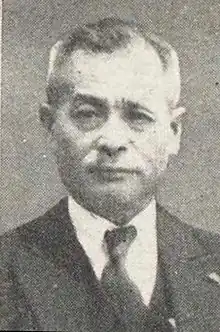Seiichi Ōmura
Seiichi Ōmura (大村 清一, Ōmura Seiichi, 4 May 1892 – 24 May 1968) was a politician and bureaucrat in the early Shōwa period Japan, who subsequently was a politician and cabinet minister in the immediate post-war era.
Ōmura Seiichi | |
|---|---|
大村 清一 | |
 | |
| Governor of Nagano Prefecture | |
| In office 15 January 1935 – 13 March 1936 | |
| Governor of Nagano Prefecture | |
| In office 11 January 1938 – 23 December 1938 | |
| Governor of Kanagawa Prefecture | |
| In office 23 December 1938 – 4 September 1939 | |
| Vice Minister for Education | |
| In office 1939–1945? | |
| Home Minister | |
| In office 22 May 1946 – 24 May 1947 | |
| House of Peers | |
| Director-General of the Japan Defense Agency | |
| In office December 10, 1954 – March 19, 1955 | |
| Prime Minister | Ichirō Hatoyama |
| Preceded by | Tokutarō Kimura |
| Succeeded by | Arata Sugihara |
| House of Representatives of Japan | |
| In office 21 November 1960 – 23 October 1963 | |
| Constituency | Okayama |
| Personal details | |
| Born | May 4, 1892 Tsuyama, Okayama, Empire of Japan |
| Died | 24 May 1968 (aged 76) |
| Alma mater | Kyoto Imperial University |
| Occupation | Politician, Cabinet Minister |
Biography
Ōmura was born in Tsuyama, Okayama. After his graduation from the Law School of Kyoto Imperial University, he entered the Home Ministry. He served as Governor of Nagano Prefecture from 15 January 1935 to 13 March 1936, and again for a second term from 11 January 1938 to 23 December 1938. He was then appointed Governor of Kanagawa Prefecture from 23 December 1938 to 4 September 1939. Later in 1939, he was Vice Minister for Education under Prime Minister Abe Nobuyuki. In 1943, he was made chairman of the Japan Student Services Organization.
After the end of World War II, during the American occupation of Japan, Ōmura served as Home Minister in the first Yoshida administration from 22 May 1946 to 24 May 1947. He was also appointed to a seat in the House of Peers in the Diet of Japan.
From 10 December 1954 to 19 March 1955, Ōmura served as Director-General for the Japan Defense Agency under the first Hatoyama administration.
Ōmura subsequently was elected a seat in the Lower House of the Diet from his native Okayama, and served for six terms from 21 November 1960 to 23 October 1963. He was awarded the Grand Cordon of the Order of the Sacred Treasure on 29 April 1965.
References
- Woodard, William Parsons. The Allied Occupation of Japan: 1945-1952 and Japanese Religions. Brill (1972). AISI v9IUAAAAIAAJ
- Kono,Masaru. Japan’s Postwar Party Politics. Princeton University Press. (1997) ISBN 0691015961
- Hunter, Janet. A Concise Dictionary of Modern Japanese History . University of California Press (1994). ISBN 0520045572
- Watt, Lori (2010). When Empire Comes Home: Repatriation and Reintegration in Postwar Japan. Harvard University Press. ISBN 978-0674055988.